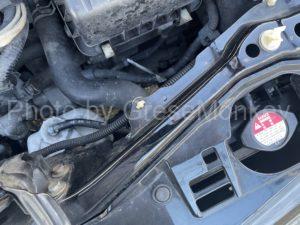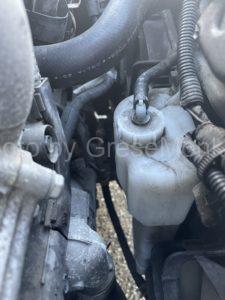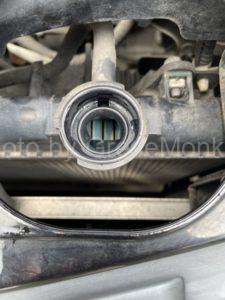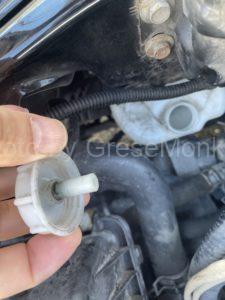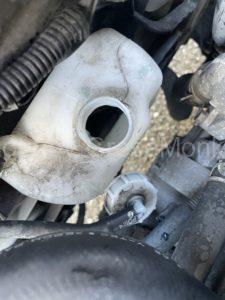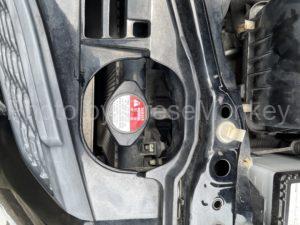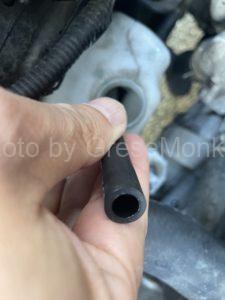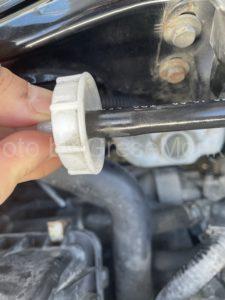Honda Fit Overheat and sub-tank
vehicle specs
- Honda Fit
- Year: December 2009
- Model: DBA-GE6
- Engine type: L13A
- Mileage: 230.000km
table of contents
Blinking temperature gauge when idling
10 minutes after stopping in the parking lot with the engine running on a midsummer day, the water temperature indicator lamp in the driver’s seat began to flash red. Immediately stop the engine, leave it for a while to cool the engine, then start the engine again, turn off the air conditioner, open all the car windows, and return home with the heater fully open. .
The reason why the heater is fully opened when overheating of the engine is suspected is that the heat of the engine can be released to the outside as much as possible. The purpose is to release it to the outside air, and it is simply because it is hot in the middle of summer.
After returning home, let the engine cool down completely, start the engine again and monitor the water temperature using the iphone application dedicated to OBD diagnosis in the idling state. After idling for nearly 10 minutes, the water temperature exceeded 100°C and the water temperature indicator lamp began flashing red.
The radiator’s electric fan spins, but it’s not cooling in time. If you run with the air conditioner turned on and the radiator fan rotating, the water temperature will hover around 90 degrees Celsius while you are driving, and if you stop at a traffic light, it will quickly exceed 100 degrees Celsius and reach 120 degrees Celsius. When I stopped the engine and restarted it, I could hear a crisp knocking sound. This is completely overheating…
Think about the cause while searching the net
When I got home, I thought about the cause while checking the current car and searching the Internet. After confirming and inspecting the current car, it was determined that there was no abnormality in the amount of water in the radiator sub-tank, the electric fan of the radiator, and the condenser fan. I can’t confirm. When I searched the internet, I found information that it was suspicious that the thermostat did not open, but I heard of a failure case where the thermostat did not open and caused overheating. In the first place, isn’t the thermostat going to stay open if it breaks down? ?
There was also information that the water temperature sensor itself may be abnormal, but if that was the case, other symptoms should have appeared in the engine, so I judged that there was no abnormality.
Unexpected cause
The next morning, I checked the engine room to check the amount of cooling water again. If the engine is cold and the radiator cap is functioning, the water level in the radiator sub-tank should be lower than the water level when I checked the radiator sub-tank immediately after driving the day before.
However, the water level did not decrease, and it had not decreased at all, as confirmed the day before. That means that the radiator cap may be the cause, so try removing the cap. While thinking that I should check the cap, I suddenly looked at the radiator…
The coolant in the sub-tank is originally blue in color, but perhaps because the coolant hasn’t been changed for nearly 200,000 km, the coolant in the sub-tank is almost black and should be attached to the sub-tank cap. The black hose came off and sank into the cooling water and disappeared completely.
The function of the radiator cap is to apply pressure to the engine cooling water passing through the entire engine from the radiator to raise the boiling point of the cooling water under atmospheric pressure (same as water) to 100°C or higher to raise the water temperature. In addition to stabilizing and preventing overheating, as the engine heats up during driving, the cooling water that expands due to the heat and increases in volume is sent to the sub-tank to stop the engine and cool the engine. The resulting negative pressure plays an important role in keeping the amount of cooling water constant by returning the amount of cooling water sent to the sub-tank back into the radiator.
In other words, the cause of the overheating this time is that the cooling water hose attached to the radiator sub-tank cap fell off, and when the engine was stopped and cooled, the cooling water that should have been sucked up by the radiator under negative pressure and returned did not return. As a result, the amount of cooling water in the engine body gradually decreased, and as a result, it is thought that overheating occurred due to lack of cooling water.
Repairs and Countermeasures
I took out the hose that was submerged in the cooling water of the radiator sub-tank using long nose pliers and a flathead screwdriver. The submerged hose, which was supposed to be attached to the sub-tank, had swelled up due to deterioration, and could not be inserted and came off easily.
So, I turned the hose over and fixed it by inserting the non-swollen tip into the cap. I think it’s good to lightly tighten it with a hose band that fits the size.
After this, I replenished the radiator with tap water, but I made a mug and drank nearly 2 liters. It was a really dangerous situation.
After that, start the engine and fully open the heater to bleed air from the cooling water, then monitor the water temperature during a test drive to make sure that it does not overheat and that the amount of cooling water in the sub-tank has increased. I parked it in the parking lot, and the next morning, when the engine was cold, I confirmed that the water level in the sub-tank had decreased, and the repair was completed.
The overheating this time was a careless mistake caused by not noticing minor problems during daily inspections, even though the mileage was over 200,000 km. In a car engine, the parts that are normally attached must be naturally attached. It made me keenly aware that performing basic inspections on a regular basis, rather than carelessly inspecting them, is the key to preventing serious failures and accidents from small mistakes like this one.
Also, it is very dangerous to just accept failure repair examples on the Internet as they are, so it is important to think carefully and cultivate an eye to determine the condition of the vehicle in front of you. I was made to realize that once again.
Simple OBD2 monitoring method
You can easily monitor vehicle information such as engine speed and water temperature by communicating with the adapter that can be connected to the OBD2 connector from the smartphone application using Bluetooth or Wifi. There are various other apps and adapters, and above all, it is compact, easy to use, and has excellent cost performance, so why not try using it as if you had it in your pocket?
Application example (iphone, android)
– OBD Auto Doctor car scanner (iphone) : https://apps.apple.com/jp/app/obd-auto-doctor-car-scanner/id908897183
– OBD Auto Doctor car scanner (android): https://play.google.com/store/apps/details?id=com.obdautodoctor&hl=en&gl=US
If the dedicated adapter is Bluetooth specification, there are several available that are compatible with the above app. It seems that the adapter you are using has been discontinued, so please search the internet and use an adapter that fits the dedicated application.
